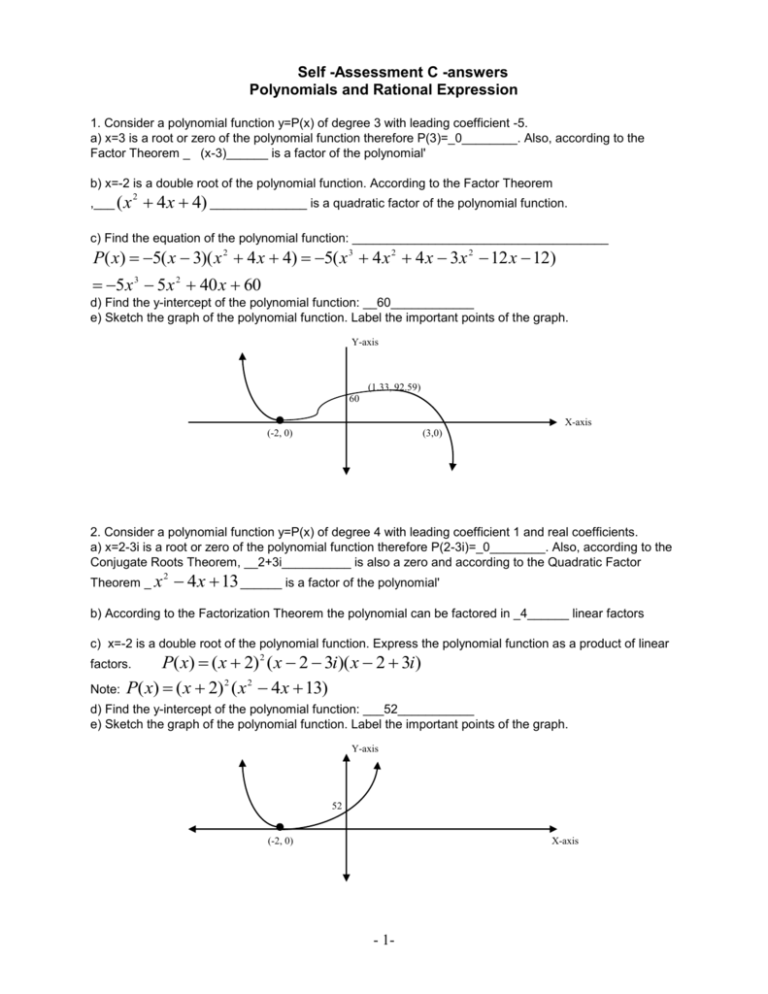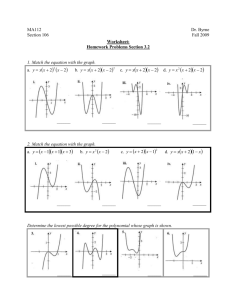answers -Polynomials and rational functions
advertisement

Self -Assessment C -answers
Polynomials and Rational Expression
1. Consider a polynomial function y=P(x) of degree 3 with leading coefficient -5.
a) x=3 is a root or zero of the polynomial function therefore P(3)=_0________. Also, according to the
Factor Theorem _ (x-3)______ is a factor of the polynomial'
b) x=-2 is a double root of the polynomial function. According to the Factor Theorem
,___ ( x
2
4 x 4) ______________ is a quadratic factor of the polynomial function.
c) Find the equation of the polynomial function: _____________________________________
P( x) 5( x 3)( x 2 4 x 4) 5( x 3 4 x 2 4 x 3x 2 12 x 12)
5 x 3 5 x 2 40 x 60
d) Find the y-intercept of the polynomial function: __60____________
e) Sketch the graph of the polynomial function. Label the important points of the graph.
Y-axis
(1.33, 92.59)
60
X-axis
(-2, 0)
(3,0)
2. Consider a polynomial function y=P(x) of degree 4 with leading coefficient 1 and real coefficients.
a) x=2-3i is a root or zero of the polynomial function therefore P(2-3i)=_0________. Also, according to the
Conjugate Roots Theorem, __2+3i__________ is also a zero and according to the Quadratic Factor
Theorem _ x
2
4 x 13 ______ is a factor of the polynomial'
b) According to the Factorization Theorem the polynomial can be factored in _4______ linear factors
c) x=-2 is a double root of the polynomial function. Express the polynomial function as a product of linear
P( x) ( x 2) 2 ( x 2 3i)( x 2 3i)
P( x) ( x 2) 2 ( x 2 4 x 13)
factors.
Note:
d) Find the y-intercept of the polynomial function: ___52___________
e) Sketch the graph of the polynomial function. Label the important points of the graph.
Y-axis
52
(-2, 0)
X-axis
- 1-
3. Use the technique of completing the square to change the quadratic function
y 2 x 2 4 x 8 to the form y k a( x h) 2
y 8 2( x 2 2 x) y 8 2 2( x 2 2 x 1) y 10 2x 1) 2
Find:
a) The y-intercept: __8____
b) The vertex: _(-1, 10)______
c) The x-intercepts: ___ 1 5 ____
2 x 2 4 x 8 0 x 2 2 x 4 0 (dividing by 2)
b b 2 4ac 2 4 4(1)( 4) 2 20 2 2 5
1 5
2a
2
2
2
d) The range: __ (, 10] _______
x
4. A farmer wishes to fence a field bordering a straight stream with 1000 yd of fencing
material. It is not necessary to fence the side bordering the stream. What is the area of
the largest rectangular field that can be fenced in this way?
Stream
Answer: _________
X
x
1000-2x
Area y= x(1000 – 2x)
y x(1000 2 x) 2 x 2 1000 x y 2( x 2 500 x)
y 125000 2( x 2 500 x 62500 ) y 125000 2 x 250
2
Maximum area is given by the vertex, it is 125000 sq. yards.
5. Use synthetic division to find the quotient Q(x) and the remainder r
if 2x 4 2x 2 3 is divided by x 2
-2
|
2
2
0
-4
-4
-2
8
6
0
-12
-12
3
24
27
Q( x) 2 x 3 4 x 2 6 x 12,
- 2-
R 27
6. If P( x) 7x 5 36x 4 7x 3 13x 2 20x 31 , use the Remainder Theorem and
synthetic division to find P(-5)
4. ____P(-5)=6__________
-5
|
7
36
-35
1
7
7
-5
2
13
-10
3
20
-15
5
31
-25
6
7. A polynomial function of degree 3 with real coefficients in standard form has a
leading coefficient of 1 and has 2 and 2-3i as zeros.
a) Find the quadratic factor of f(x) with integer coefficients which has 2-3i as a zero.
If 2 3i is a zero, 2 3i is also a zero.
Therefore x 2 (c1 c2 ) x c1c2 x 2 4 x 13 is a quadratic factor
2
answer: ____ x 4 x 13 is a quadratic factor ______________
b) Find a polynomial function f(x) which satisfies the conditions of the problem.
P( x) ( x 2)( x 2 4 x 13) x 3 4 x 2 13x 2 x 2 8x 26 x 3 6 x 2 21x 26
3
2
answer:__ P( x) x 6 x 21x 26 __________________
8. Consider the polynomial function P( x) x 4 6x 3 5x 2 24x 36
a) Use synthetic division to find the zeros of the polynomial.
3a.___________
According to the rational roots theorem, the possible rational roots
are 1,2, 3, 4, 6, 9, 12, 18, 36
-2
|
1
3
|
1
1
-6
-2
-8
3
-5
5
16
21
-15
6
24
-42
-18
18
0
-36
36
0
x + 2 is a factor
x-3 is a factor
x 2 5x 6 ( x 2)( x 3) are factors
The zeros are –2, 2,and 3 which has multiplicity 2.
- 3-
b) Express the polynomial function in factored form:
P( x) ( x 2)( x 2)( x 3) 2
c) Sketch the graph of the polynomial.
y-intercept = -36____
x-intercept =_-2, 2, 3____
y
-2
9. Sketch the graph of
2
3
x
y x( x 1) 2 ( x 3) . Use the graph to find the solution of the inequality
x( x 1) 2 ( x 3) 0 . Give answer in interval notation.
-1
3
x-
axis
The solution of the inequality
or below the x- axis.
x( x 1) 2 ( x 3) 0 is given by the values of x for which the graph is on
answer : {1} [0, 3]
- 4-
2x 2 3x 5
10. Find all the asymptotes of y
x2
Solution: by synthetic division
2 | 2
-3
5
4
2
2
1
7
2x 2 3x 5
7
y
2x 1
x2
x2
7
0 and the function y
x2
approaches the slant asymptote y 2x 1
For l arg e values of x, that is, x ,
Answer: x=2 is a vertical asymptote and y = 2x + 1 is a slant asymptote_____
11.. Use synthetic division and the rational roots theorem to find the solution of the
equation 12 x 3 4x 2 5x 2 0
a) The possible values of the rational zeros are
The divisors of the leading coefficient p are {1, 2}
The divisors of the constant term q are {1, 2, 3 , 4, 6, 12}
p
1
1
2
1
1
1
1, 2, , , , , ,
q
2
3
3
4
6 12
b) The solutions or roots are ______________________
Show the work (use synthetic division)
2
12
4
5 2
3
8
8 2
The possible values of the rational zeros c
12
12
3
0
2
is a zero or root and 12x 2 12x 3 is a quadratic factor .
3
12x 2 12x 3 0 4x 2 4x 1 0 ( 2x 1)( 2x 1) 0
1
is a zero of double multiplici ty
2
2
1
1
The solutions or zeros are , ,
3
2
2
x
- 5-
12. Consider the function
P( x) 2x 4 9x 3 3x 2 16 x 6
a. Give the list of all possible rational zeros of the function.
The divisors of the leading coefficient p are {1, 2, 3, 6}
The divisors of the constant term q are {1, 2}
The possible values of the rational zeros
p
1
1
3
c 1, 2, 3, 6, , ,
q
2
3
2
b) Use Descartes’ rule of signs to complete the following table for the possible zeros
of the functions
Number of positive real roots 2 or 0
2
2
0
0
Number of negative real roots 2 or 0
2
0
2
0
Number of complex roots (imaginary)
0
2
2
4
total number of roots or zeros
4
4
4
4
c) Show that c=
1
2
2
1
is a zero (use synthetic division)
2
9
1
2
10
3 16
5
8
6
4
6
-12
0
d) Find the exact value of the other solutions : __________________
-3 |
2
10
8
-12
2
-6
4
-12
-4
12
0
2x 2 4x 4 0 x 2 2x 2 0 x
2 4 4(1)( 2)
2
2 12 2 2 3
1 3
2
2
1
The solutions or roots are 3, , 1 3 and 1 3
2
x
- 6-
13. Sketch the graph of
y
x 22
(2x 3)( x 1)2
a) x-intercept: x = -2____
4
_____
3
3
c) Vertical asymptotes: x 1, x ______
2
d) Horizontal asymptote: y = 0 (the x-axis) because the degree of the numerator is
less than the degree of the numerator._______
1
e) f ( 1)
4
g) Graph
b) y-intercept: when x 0, y
xX==-1.5
y-axis
x ==1
x-axis
h) the solution of
x 22
( 2x 3)( x 1)2
0
is [-2, -1.5)
- 7-
(use interval notation)
14 . Sketch the graph of y
x( 2x 1)
( x 2) 2
a) x – intercepts: when y = 0 , x = 0, x
1
2
b) y-intercept: when x 0, y 0 _____
c) Vertical asymptotes: x = 2
d) Horizontal asymptote: y = 2 because the degree of the numerator is equal than the
degree of the numerator._______
e) f (1) 3
y-axis
x=2
y =2
X=-0.5
x( 2x 1)
The solution of
( x 2)
2
0
is
x-axis
1
, ),2) ( 2, ) (use interval notation)
2
- 8-
( x 2) 2 ( x 2)( x 3)( x 1) 2
( x 3)( x 1)
a) The degree of the numerator is 6 ___________
15. Consider the rational function y
b) The degree of the numerator is 2______________
c) At the end-points, the rational function behaves like the power function
___ y x 4 _________
d) The function has a vertical asymptote given by the equation x = 1___________
e) The y-intercept of the function is y = -8_____________
f) The x-intercepts of the function are x = -2, x = -1, x = 2_______________
h) The function has a hole at x= 3 ______________
i) The hole of the function has coordinates x = 3 ___ and y = 40 _______
k) Sketch the graph of function. Label the must important points.
y-axis
o
40
-2
-1
1
x=1
- 9-
2
3
x -axis








